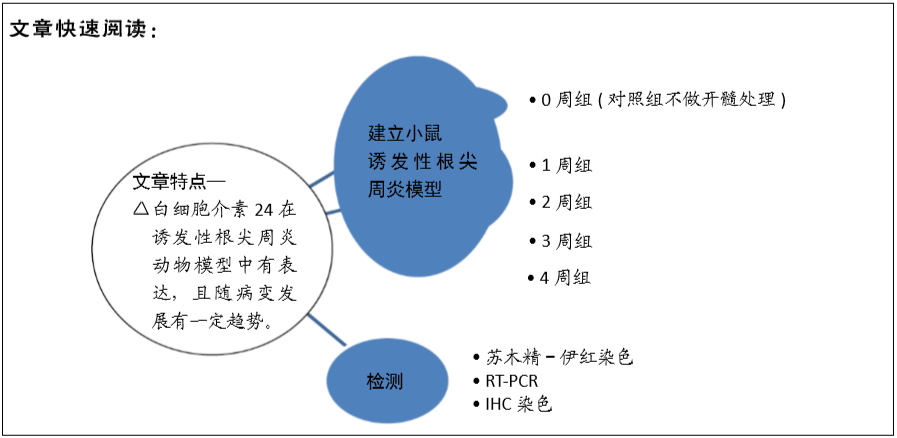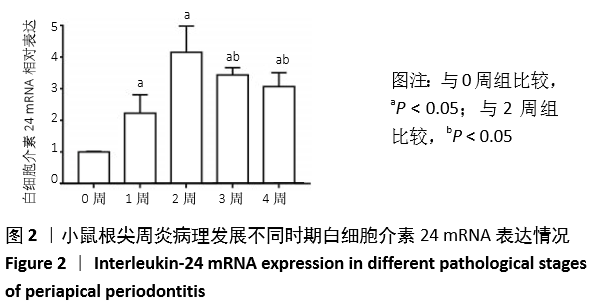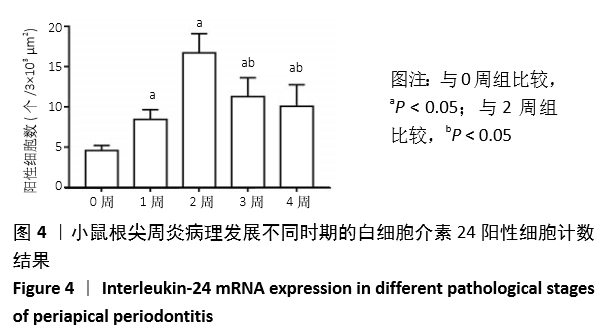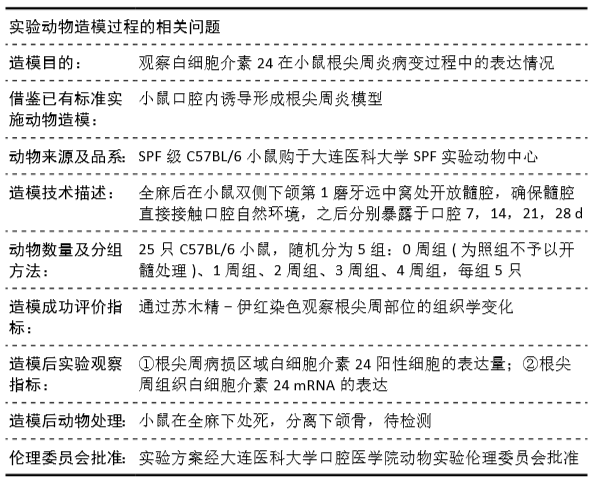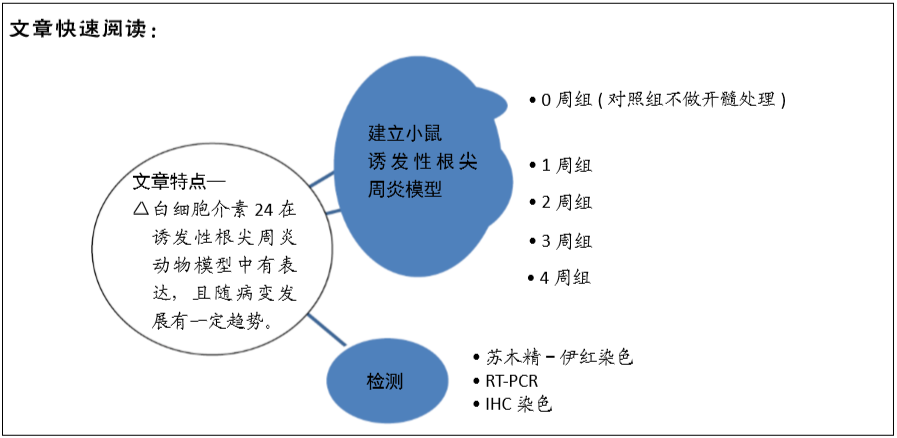[1] 徐阳,刘瑾,汪秀娟,等.慢性根尖周炎临床特征分析与治疗[J].全科口腔医学电子杂志,2018,5(10):64-65.
[2] SASAKI H, HIRAI K, MARTINS CM, et al. Interrelationship between periapical lesion and systemic metabolic disorders.Curr Pharm Des. 2016;22(15):2204-2215.
[3] WEBER M, KESTING M, WEHRHAN F,et al. Differences in Inflammation and Bone Resorption between Apical Granulomas, Radicular Cysts, and Dentigerous Cysts.J Endod.2019;45(10):1200-1208.
[4] 岳林.根尖周炎临床诊断和预后与组织病理学表现的相关性[J].中华口腔医学杂志,2010,45(3):177-181.
[5] GOMES BPFA, HERRERA DR. Etiologic role of root canal infection in apical periodontitis and its relationship with clinical symptomatology. Braz Oral Res.2018;18;32(suppl 1):e69.
[6] BRAZ-SILVA PH, BERGAMINI ML,JONASSON P, et al. Inflammatory profile of chronic apical periodontitis: a literature review.Acta Odontol Scand.2019;77(3):173-180.
[7] RAEBER ME, ZURBUCHEN Y, IMPELLIZZIERI D, et al. The role of cytokines in T- cell memory in health and disease.Immunol Rev.2018; 283(1):176-193.
[8] JAKOVLJEVIC A, KNEZEVIC A, KARALIC D, et al. Pro-inflammatory cytokine levels in human apical periodontitis: Correlation with clinical and histological findings.Aust Endod J.2015;41(2):72-77.
[9] PERSAUD L, DE JESUS D, SAUANE M, et al. Mechanism of Action and Applications of IL-24 in Immunotherapy.Int J Mol Sci.2016;17(6): 523-534.
[10] WOLK K, KUNZ S, SABAT R, et al. Immune cells as sources and targets of the IL-10 family members? J. Immunol.2002;168: 5397-5402.
[11] JIANG H, GOLDSTEIN NI, FISHER PB, et al. Subtraction hybridization identifies a novel melanoma differentiation associated gene,mda-7, modulated during human melanoma differentiation, growth and progression. Oncogene.1995;11:2477-2486.
[12] TIAN H, ZHANG D, GAO Z, et al. MDA-7/IL-24 inhibits Nrf2-mediated antioxidant response through activation of p38 pathway and inhibition of ERK pathway involved in cancer cell apoptosis.Cancer Gene Ther. 2014;21(10):416-426.
[13] TAKAHASHI K, MACDO D, KINANE D, et al. Cell synthesis, proliferation and apoptosis in human dental periapical lesions analysed by in situ hybridisation and immunohistochemistry.Oral Dis.1999;5(4):313-320.
[14] KRAGSTRUP TW. The IL-20 receptor axis in immune-mediated inflammatory arthritis: novel links between innate immune recognition and bone homeostasis.Scand J Rheumatol.2016;45(sup128):53-57.
[15] AGGARWAL S, CHADA S, AGGARWAL BB, et al. Melanoma differentiation-associated gene-7/IL-24 gene enhances NF-kappa B activation and suppresses apoptosis induced by TNF.J Immunol. 2004; 173(7):4368-4376.
[16] WEI H, SUN A, GUO F, et al. Interleukin-10 Family Cytokines Immunobiology and Structure.Adv Exp Med Biol.2019;1172:79-96.
[17] GREISEN SR, EINARSSON HB, KRAGSTRUP TW, et al. Spontaneous generation of functional osteoclasts from synovial fluid mononuclear cells as a model of inflammatory osteoclastogenesis.APMIS. 2015; 123(9):779-786.
[18] GOMES BPFA, HERRERA DR. Etiologic role of root canal infection in apical periodontitis and its relationship with clinical symptomatology.Braz Oral Res.2018;32(suppl 1):e69.
[19] KINANE DF, LAPPIN DF, BUCKLEY A, et al. Humoral immune responses in periodontal disease may have mucosal and systemic immune features. Clin Exp Immunol.1999;115(3):534-541.
[20] GRAVES DT, OATES T, GARLET GP. Review of osteoimmunology and the host response in endodontic and periodontal lesions.J Oral Microbiol. 2011; 3(10):3402-3421.
[21] COLIĆ M, GAZIVODA D, LUKIĆ A, et al. Proinflammatory and immunoregulatory mechanisms in periapical lesions.Mol Immunol. 2009;47(1):101-113.
[22] MENEZES R, GARLET TP, FIGUEIRA RC, et al. Differential patterns of receptor activator of nuclear factor kappa B ligand/osteoprotegerin expression in human periapical granulomas: possible association with progressive or stable nature of the lesions.J Endod.2008;34(8):932-938.
[23] GARLET GP. Destructive and protective roles of cytokines in periodontitis: a re-appraisal from host defense and tissue destruction viewpoints.J Dent Res.2010;89(12):1349-1363.
[24] WALKER KF, LAPPIN DF, KINANE DF, et al. Cytokine expression in periapical granulation tissue as assessed by immunohistochemistry.Eur J Oral Sci. 2000;108(3):195-201.
[25] DE CARVALHO FRAGA CA, ALVES LR, DE SOUSA AA, et al. Th1 and Th2-like protein balance in human inflammatory radicular cysts and periapical granulomas.J Endod. 2013;39(4):453-455.
[26] CELLA M, FUCHS A, OTERO K, et al. A human natural killer cell subset provides an innate source of IL-22 for mucosal immunity. Nature.2009; 457:722-725.
[27] ALANÄRÄ T, KARSTILA K, ISOMÄKI P, et al.Expression of IL‐10 family cytokines in rheumatoid arthritis: elevated levels of IL‐19 in the joints.Scand J Rheumatol.2010; 39:118-126.
[28] FONSECA‐CG, GRANADOS J, YAMAMOTO‐FJK, et al.Expression of interleukin (IL)‐19 and IL‐24 in inflammatory bowel disease patients: a cross‐sectional study.Clin Exp Immunol.2014;177:64-75.
[29] SZIKSZ E, PAP D, LIPPAI R,et al.Fibrosis related inflammatory mediators: role of the IL‐10 cytokine family.Mediat Inflamm.2015;2015:641-664.
[30] MENEZES ME, BHOOPATHI P, PRADHAN AK, et al. Role of MDA-7/IL-24 a Multifunction Protein in Human Diseases.Adv Cancer Res. 2018; 138:143-182.
[31] SOROKIN AV, NORRIS PC, ENGLISH JT, et al.Identification of proresolving and inflammatory lipid mediators in human psoriasis.J Clin Lipidol. 2018;12(4):1047-1060.
[32] TAMAI H, MIYAKE K, YAMAGUCHI H,et al. AAV8 vector expressing IL24 efficiently suppresses tumor growth mediated by specific mechanisms in MLL/AF4-positive ALL model mice.Blood.2012;119:64-71.
[33] JIN SH, CHOI D, CHUN YJ,et al. Keratinocyte-derived IL-24 plays a role in the positive feedback regulation of epidermal inflammation in response to environmental and endogenous toxic stressors.Toxicol Appl Pharmacol.2014;280:199-206.
[34] BUZAS K, MEGYERI K. Staphylococci induce the production of melanoma differentiation-associated protein-7/IL-24.Acta Microbiol Immunol Hung.2006;53(4):431-440.
[35] MITAMURA Y, NUNOMURA S, IZUHARA K,et al. IL-24: A new player in the pathogenesis of pro-inflammatory and allergic skin diseases.Allergol Int.2020;S1323-8930(19)30200-X.
[36] KRAGSTRUP TW, ANDERSEN MN, DELEURAN B,et al.Increased interleukin (IL)-20 and IL-24 target osteoblasts and synovial monocytes in spondyloarthritis.Clin Exp Immunol. 2017;189(3):342-351.
[37] KRAGSTRUP TW, ANDERSEN T,DELEURAN B, et al.The IL‐20 cytokine family in rheumatoid arthritis and spondyloarthritis.Frontiers in Immunology.2018;9;2226.
[38] PASPARAKIS M,HAASE I,NESTLE FO. Mechanisms regulating skin immunity and inflammation.Nat Rev Immunol.2014 May;14(5): 289-301.
[39] KO YK,AN SJ,CHOI BK,et al.Regulation of IL-24 in human oral keratinocytes stimulated with Tannerella forsythia.Mol Oral Microbiol. 2019;34(5):209-218.
[40] PAP D, SZIKSZ E, KISS Z, et al. Microarray Analysis Reveals Increased Expression of Matrix Metalloproteases and Cytokines of Interleukin-20 Subfamily in the Kidneys of Neonate Rats Underwent Unilateral Ureteral Obstruction: A Potential Role of IL-24 in the Regulation of Inflammation and Tissue Remodeling.Kidney Blood Press Res. 2017; 42(1):16-32.
[41] MA Y, YAN J, ZHANG XL,et al. IL-24 protects against Salmonella typhimurium infection by stimulating early neutrophil Th1 cytokine production, which in turn activates CD8+ T cells.Eur J Immunol. 2009; 39(12):3357-3368. |
